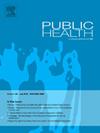Preventable deaths related to thromboembolism in England and Wales, 2013-2022: A systematic case series of coroners’ reports
IF 3.2
3区 医学
Q1 PUBLIC, ENVIRONMENTAL & OCCUPATIONAL HEALTH
引用次数: 0
Abstract
Objectives
To identify preventable thromboembolism-related deaths, classify coroner concerns, and explore organisational responses.
Study design
Retrospective systematic case series of coroners’ Prevention of Future Deaths reports (PFDs) from 1 July 2013 to 16 November 2022, in England and Wales.
Methods
Reports were acquired from the Courts and Tribunals Judiciary website and screened for thromboembolism-related deaths using a reproducible automated computer code. Demographic information, coroners’ concerns, and organisational responses to PFDs were extracted and analysed, including risk factors predisposing to thromboembolism.
Results
112 PFDs (2.7 % of all PFDs) involved a thromboembolism event contributing to death. The average age of death was 59 years, corresponding to an estimated median of 25 years of life lost per death. Just over half of deaths occurred in women (52 %). The most common cause of death was pulmonary embolism (85.7 %). Issues with thromboprophylaxis were common, including incorrect risk assessments (27.7 %). Coroners’ concerns most often related to failures in providing adequate care, including communication failures (15.7 %), issues with following protocols and guidelines (11.8 %), and risk assessments (10.8 %). Only 56 % of organisations who were sent a PFD had a published response. When they did respond, the majority of responses reported initiating changes related to improvements to guidelines and protocols, or education and training.
Conclusions
PFDs offer unique insights into the systems and processes leading to preventable thromboembolism-related deaths. Improved awareness and dissemination of PFDs among clinicians and policy-makers, alongside routine monitoring of PFDs, has the potential to improve patient safety and reduce preventable harms from thromboembolic events.
2013-2022年英格兰和威尔士与血栓栓塞相关的可预防死亡:验尸官报告的系统病例系列
目的确定可预防的血栓栓塞相关死亡,分类验尸官关注的问题,并探讨组织应对措施。研究设计:2013年7月1日至2022年11月16日,英格兰和威尔士验尸官预防未来死亡报告(PFDs)的回顾性系统病例系列。方法从法院和法庭司法网站获取报告,并使用可重复的自动计算机代码筛选血栓栓塞相关死亡。提取和分析了人口统计信息、验尸官关注的问题和组织对PFDs的反应,包括易患血栓栓塞的危险因素。结果112例PFDs(占所有PFDs的2.7%)涉及导致死亡的血栓栓塞事件。平均死亡年龄为59岁,相当于每例死亡估计损失25年的中位数寿命。一半以上的死亡发生在妇女身上(52%)。最常见的死亡原因是肺栓塞(85.7%)。血栓预防问题很常见,包括不正确的风险评估(27.7%)。验尸官最担心的是未能提供足够的护理,包括沟通失败(15.7%)、遵循协议和指南的问题(11.8%)和风险评估(10.8%)。在收到PFD的组织中,只有56%的组织发表了回应。当他们做出回应时,大多数回应报告了与改进指导方针和协议或教育和培训有关的变化。结论spd对可预防的血栓栓塞相关死亡的系统和过程提供了独特的见解。在临床医生和政策制定者中提高PFDs的认识和传播,以及对PFDs的常规监测,有可能提高患者安全性并减少血栓栓塞事件的可预防危害。
本文章由计算机程序翻译,如有差异,请以英文原文为准。
求助全文
约1分钟内获得全文
求助全文
来源期刊

Public Health
医学-公共卫生、环境卫生与职业卫生
CiteScore
7.60
自引率
0.00%
发文量
280
审稿时长
37 days
期刊介绍:
Public Health is an international, multidisciplinary peer-reviewed journal. It publishes original papers, reviews and short reports on all aspects of the science, philosophy, and practice of public health.
 求助内容:
求助内容: 应助结果提醒方式:
应助结果提醒方式:


